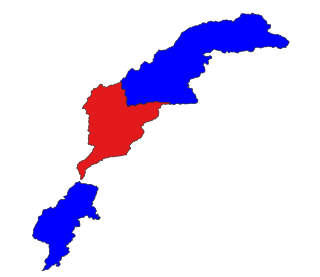Related Research Articles

Nagas are various ethnic groups native to northeastern India and northwestern Myanmar. The groups have similar cultures and traditions, and form the majority of population in the Indian state of Nagaland and Naga Self-Administered Zone of Myanmar (Burma); with significant populations in Manipur, Arunachal Pradesh and Assam in India; Sagaing Region and Kachin State in Myanmar.
The Konyak languages, or alternatively the Konyakian, Northern Naga, or Patkaian languages, is a branch of Sino-Tibetan languages spoken by various Naga peoples in southeastern Arunachal Pradesh and northeastern Nagaland states of northeastern India. They are not particularly closely related to other Naga languages spoken further to the south, but rather to other Sal languages such as Jingpho and the Bodo-Garo languages. There are many dialects, and villages even a few kilometers apart frequently have to rely on a separate common language.

Lahe Township is a township located within the Naga Self-Administered Zone of Sagaing Division, Myanmar. The principal town is Lahe.
Konyak is a Sino-Tibetan language spoken by the Konyak people in the state of Nagaland, north-eastern India. It is written using the Latin script.

Tangsa, also known as Tase and Tase Naga, is a Sino-Tibetan language or language cluster spoken by the Tangsa people of Burma and north-eastern India. Some varieties, such as Shangge (Shanke), are likely distinct languages. There are about 60,000 speakers in Burma and 40,000 speakers in India. The dialects of Tangsa have disparate levels of lexical similarity, ranging from 35%–97%.
Khiamniungan is a Sino-Tibetan language spoken by the Khiamniungan people in east-central Noklak District of Nagaland in northeastern India and in northwestern Burma. Most of the Khiamniungans in India are acquainted with Patsho Khiamniungan which is also one of the main languages within their geographical region.
Khumi, or Khumi Chin, is a Kuki-Chin-Mizo language of Burma, with some speakers across the border in Bangladesh. Khumi shares 75%–87% lexical similarity with Eastern Khumi, and 78-81% similarity with Mro-Khimi.
Kayan, also known as, Padaung or Padaung Karen) is a Karen language of Burma, spoken by the Kayan people. The Kayan dialects share more than 90% lexical similarity. Padaung is 71% to 76% lexically similar to Lahta.

Palaung or Ta'ang, also known as De'ang, is a Austroasiatic dialect cluster spoken by over half a million people in Burma and neighboring countries. The Palaung people are divided into Palé (Ruching), Rumai, and Shwe, and each of whom have their own language. The Riang languages are reported to be unintelligible or only understood with great difficulty by native speakers of the other Palaung languages.
Senthang is a Kuki-Chin-Mizo language of Burma. The Senthang dialects share 79% to 95% lexical similarity.
Somra, also known as Burmese Tangkhul, is a Sino-Tibetan language spoken in Myanmar. The two ethnic Tangkhul languages are related, but are not mutually intelligible, being only 30% lexically similar. Somra is closer to Akyaung Ari.
Akyaung Ari, or Ngachan, is a Tangkhulic language spoken in Myanmar. It is most closely related to Somra. It is spoken in Heinkut, Jagram, and Ngachan villages of Leshi Township, Sagaing Division, Myanmar. Ngachan shares 52% lexical similarity with Tanghkul Naga of Somra, 23% with Tangkhul Naga of Ukhrul in India, and 23% with Koki Naga.
Lainong Naga, or Htang Ngan, is a Sino-Tibetan language spoken in Burma. Lainong Naga is spoken in about 32 villages of Lahe Township and northwestern Hkamti Township, Naga Self-Administered Zone, Sagaing Division, Myanmar (Ethnologue). Dialects are Zëūdiāng.
Ponyo, or Ponyo-Gongwang after its two dialects, is a Sino-Tibetan language spoken in Burma. Ponyo is spoken in 19 villages of Lahe Township, Naga Self-Administered Zone, Sagaing Division, Myanmar (Ethnologue). Dialects are Ponyo and Gongwang, with high mutual intelligibility between the two, both of which share 89% to 91% lexical similarity.
Songlai is a Kuki-Chin language of Burma. It is 90% lexically similar to Laitu Chin, but not mutually intelligible. Dialects are Doitu, Hettui, Mang Um (Song), and Lai.
Koki, or Koki Naga, is an unclassified Sino-Tibetan language spoken in Burma. Speakers are included under the wider Naga ethnicity. It has been documented in Shintani (2018).
Long Phuri, or Long Phuri Naga, is an unclassified Naga language of Burma. Long Phuri is spoken in 6 villages of Leshi Township, Hkamti District, Sagaing Region, Myanmar.
Makury, or Makury Naga, is a Naga language of India and Myanmar. Shi (2009:3) and Saul (2005:25) suggest that Makury may be an Ao language. The Makury dialects share 93% lexical similarity.
Para or Para Naga, is an unclassified Naga language of India and Burma. It is not close to other Naga languages which it has been compared to, though Para Naga, Long Phuri Naga, and Makuri Naga may be closest to each other, with Para the most distinct. Barkman (2014) notes that Para Naga could possibly be an Ao or Tangkhulic language. Saul (2005) classifies Para Naga as an Ao language. Hsiu (2021) classifies Para as a sister of the Central Naga (Ao) languages.
Ganan is a Sino-Tibetan language of northwestern Myanmar, spoken in Sagaing Region. It belongs to the Luish branch, and is most closely related to the Kadu language of Myanmar, with which it shares 84 to 89% lexical similarity. The Ganan dialects share 95 to 99% lexical similarity.
References
- ↑ Makyam at Ethnologue (18th ed., 2015) (subscription required)
- 1 2 "Myanmar". Ethnologue: Languages of the World. 2016. Archived from the original on 2016-10-10.
- 1 2 3 4 5 Naw Sawu. 2016. Descriptive Phonology of Makyam Naga . M.A. dissertation. Chiang Mai: Payap University.
